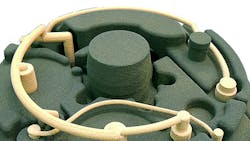ExOne’s Cold-Hardening Phenol Binder in Production Now
The ExOne Company’s “cold hardening phenol” (CHP) binder agent is now in commercial operation on a machine in Freiberg, Germany, for prototype casting producer, ACTech GmbH. It is the first 3D printer in the world using the new binder, which was first reported last September as a further development of the phenolic binder formulations ExOne debuted in 2013.
According to the developer, ACTech is able now to produce prototypes of challenging designs more quickly and cost-effectively. “Compared to traditional rapid prototyping procedures, this new technology enables the production of high-strength molds and cores for sand castings, which until now were achievable only with laser sintering,” according to an ExOne announcement.
3D printing is used to produce sand molds and cores according to CAD designs that are converted to STL files and then recreated in layers by the 3D printer. ExOne designs and supplies the printing machines and technology, as well as the binder. In addition to printing sand, ExOne’s technology is able to print designs in metal alloys and ceramics.
The new CHP formulation follows the initial series of phenolic binders ExOne introduced in 2013, allowing foundries to cast higher heat alloys, create stronger molds and/or cores, and improve casting quality by reducing the amount of expansion exhibited by the mold or core.
ExOne also contends the new CHP binder will accelerate the 3D printing process because it does not require an infrared heating (as with traditional phenolic binders): polymerization may occur at room temperature, which cuts down printing and curing time and requires no additional heating equipment. If further drying is desired it can be done in a conventional air oven.
ACTech has prototype and rapid casting operations at Freiberg, Germany; Vasantnagar, Bangalore, India; and Ann Arbor, MI — ACTech North America Inc. It designs and produces small-batch castings and prototypes. “Compared to traditional rapid prototyping procedures, this new technology enables the production of high strength molds and cores for sand castings, which until now were achievable only with laser sintering,” ExOne noted.
The supplier called ACTech “the perfect partner for ExOne to collaborate with in developing the cold 3D phenolic printing process.” This process uses less binder while producing complex, load-bearing cores and molds. ACTech also reduced the use of binder significantly compared to other binder formulations, which has the effect of cutting down gas occlusions. And, eliminating curing time means ACTech can produce more challenging and fragile molds, quicker and with a decreased reject rate.
"With our focus on accelerating the adoption rate of our technology particularly in the foundry markets, we are excited to offer this new binder solution,” offered Rainer Hoechsmann, ExOne’s chief development officer. “Our customers are pleased with the strength, surface finish, and high temperature resistance of our cores and mold packages printed with CHP, particularly for light metal castings, such as aluminum, magnesium, iron and steel."
About the Author
Robert Brooks
Content Director
Robert Brooks has been a business-to-business reporter, writer, editor, and columnist for more than 20 years, specializing in the primary metal and basic manufacturing industries. His work has covered a wide range of topics, including process technology, resource development, material selection, product design, workforce development, and industrial market strategies, among others.
